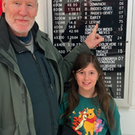Learn about mid-18th-Century building in our area
— Photo from Judy Kimes
This stone house, built in 1756 by Gerrit VanZandt on land purchased from Stephen Van Rensselaer, will be one of the properties discussed in the New Scotland Historical Association’s Nov. 7 presentation, “Getting the Job Done: Construction, Builders, and Building Materials in the Upper Hudson and Mohawk Valleys, 1755-1765,” given by architectural historian Walter Wheeler.
To the Editor:
The French and Indian War saw a building boom in our region that included the construction of “mansions” modeled after English “country seats.” Architectural historian Walter Wheeler will present a program examining the construction practices, material acquisition, and labor sources used to construct these buildings.
One such building is the stone home on Onesquethaw Creek Road. According to the New Scotland Historical Association’s book, “Images of America: New Scotland Township” (2000), this house “was built in 1756 by Gerrit VanZandt on land purchased from Stephen Van Rensselaer. It was partially fortified during the French and Indian War with bars on the lower windows. The top floor served as a barracks for British troops garrisoned there.”
Gerrit VanZandt and his family owned several properties in Albany. However, he operated a mill on the Onesquethaw Creek. In 1805, he bequeathed this “farm on the Onesquethaw” to his grandson.
Locally known by some as the Touhey House, it is but one of several structures built in this area during this time period.
Walter Wheeler has extensive experience in the field of architectural history. He researches and has written several publications about architectural and material cultural history. He is currently preparing a book entitled “Building Albany: Studies in the Vernacular Architecture of the Upper Hudson and Lower Mohawk Valleys.”
Vernacular architecture is sometimes defined as construction using locally available materials and planned and erected by local builders rather than by architects. The knowledge of how to build these structures was handed down and often came about through experience rather than from formal calculations using geometry and physics.
Come and learn what actually went into the construction of the many beautiful, centuries-old structures still standing in our community. This interesting and informative program will be presented at 2 p.m. on Sunday, Nov. 7, at the Wyman Osterhout Community Center in New Salem on 7 The Old New Salem Road. Admission is always free.
On the same day and at the same location, please take the opportunity to take in the exhibits at the NSHA Museum, featuring the commemoration of the 75th anniversary of the end of World War II. The museum will be open for a half-hour before the program.
Please be aware that the Town of New Scotland requires attendees to wear masks.
Judy Kimes
Publicist
New Scotland
Historical Association

